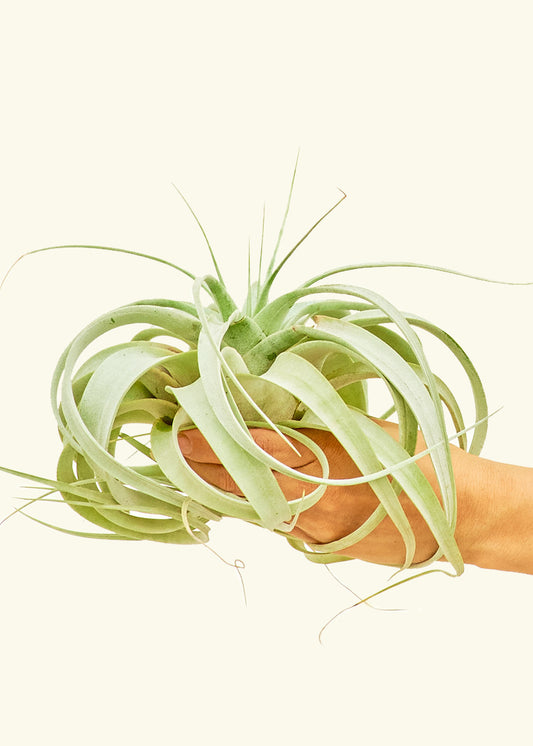Air Plants: Overview
Discover the graceful and clean world of Air Plants (Tillandsia), charming epiphytes that don’t need soil to grow!
These amazing, soil-free plants are native to Central and South America, with some varieties also growing in the southern US regions. Tillandsia Air Plants are low-maintenance, mess-free, and ideal for beginners, as they require no potting soil or repotting. These tropical beauties thrive in bright light and high humidity. Air Plants are safe for pets, too, since they are non-toxic. Tillandsia symbolizes endurance, freedom, and harmony, and many people buy Air Plants as gifts for loved ones who need encouragement and inspiration.
Air Plants are versatile houseplants that are fun to grow and decorate with. The possibilities of using them in stylish arrangements include mounting these lovely plants on driftwood, growing them in a bowl or a seashell, or displaying them in hanging compositions.
Benefits of Air Plants
- Soil-free and mess-free growing
- Air-cleansing properties that help filter toxins from the air
- Stress-relieving and mood-boosting effect
- Pet-friendliness
- Unique shape and exotic blooms
Air Plant Care: Growing Guide
Once you know how to take care of Air Plants, they are incredibly low-maintenance and fun to grow. Choosing the right environment is a key step in Tillandsia care.
Light, Humidity, and Temperature
Air Plants need plenty of bright but indirect light. Direct sun can scorch their leaves, leaving unsightly brown marks. Mist regularly or use a humidifier to maintain high humidity. Choose a place with good air flow for your Air Plants to keep them healthy and happy. Temperatures of 60°F– 90°F are ideal for Tillandsias. In warmer climates, you can also grow Air Plants in partial shade on the porch, as long as the night temperatures stay above 60°F.
Watering and Feeding
This is how to water Air Plants: submerge them in water for about 30-40 minutes. Use filtered or distilled water. Turn the Air Plant upside down after watering, and leave it on a towel to dry. Another method is to mist the plants thoroughly, ensuring that they dry afterwards. When watering glue-mounted Air Plants, misting or dipping them in water works best.
Feed your Tillandsia plants by dissolving some low-nitrogen fertilizer for bromeliads in distilled water and misting the plants.
Propagation
Propagating Air Plants is easy, since they develop pups at the base of the plant. Detach the pups when they reach about one-third of the mother plant’s size.
Pruning, Cleaning, and Common Issues
No pruning is necessary for Tillandsia plants. Simply trim any damaged leaves, dead roots, or wilted flowers. Normally, Air Plants aren’t prone to pest infestations or diseases. Yellowing, soft leaves are a sign of overwatering. Underwatered plants, on the other hand, have crisp, brown, curling leaves.
Types of Air Plants: Shop From Our Collection
The versatility and unique look of Air Plants make them popular additions to homes and offices. You can display an Air Plant on your desk or decorate a window with Tillandsias in hanging containers. Here are some top choices available at Hey Rooted:
King of Air Plants
Description: The magnificent King of Air Plants (Tillandsia xerographica) has curling, silvery leaves and comes in three different sizes.
Giant Air Plant
Description: One of the rare Air Plants for sale, the Giant Air Plant (Tillandsia fasciculata 'Tropiflora') will produce exotic spike-like blooms if provided with the right light and regular watering.
Spanish Moss
Description: The atmospheric southern Spanish Moss (Tillandsia usneoides) is soft and silver grey, trailing its wispy strands from wherever you decide to hang it.
Intrigued by the wonder of these soil-free epiphytic plants? Buy a 5-pack or 10-pack of assorted Mystery Tillandsia plants for sale to create artistic displays around your home.
Get Cute & Rare Air Plants for Sale From Hey Rooted Now!














